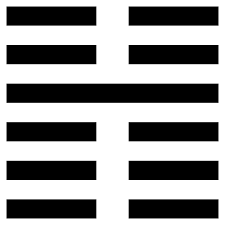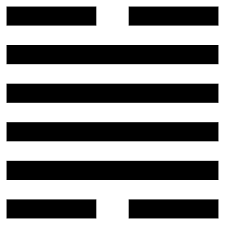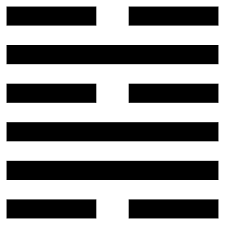
I Ching Reading for the New Year
by Nori Muster
The I Ching, Yi Jing, also known as the Book of Changes, came into being simultaneous with early Chinese writing, prior to 2000 BCE. Each hexagram addresses life's changes and the hexagrams weigh the best and worst attitudes to flow with the changes.
I consulted the I Ching with these questions: "What changes will we face in the coming year and what are the best attitudes for the new year?" To learn more, we will examine Hexagram 16 - Harmony, Hexagram 28 - Imperfection, and Hexagram 48 - Uniting Force.
 Hexagram 16 - Harmony
Hexagram 16 - Harmony
This hexagram describes the mood when things are going well. We all experience times when life showers us with blessings and goodness. During times like this, people feel energized and Hexagram 16 indicates it's a time to take another step forward. During times of peace we can get started solving an old problem or imagining a new project.
However, Hexagram 16 warns against taking a negative attitude in good times. The six lines of the hexagram describe bad attitudes and good attitudes, offering three examples of each.
The first line, yin, shows "a self-satisfied person bragging about their happy condition." First of all, arrogance sets a person up for a fall. Second, listening to someone brag can be irritating, so arrogant people may not have a lot of friends. We don't have to explain it to people. If we feel good about our accomplishments it will shine through.
The second line, yin, shows "the subject acting on intuition without hesitating." In a time of harmony, people can act spontaneously with no need to consider their ego. Working cooperatively together in good times moves projects forward.
The third line, yin, shows someone "in a position for which they are not suited who looks to heaven to supply happiness and success." This line warns us that magical thinking is not a solid foundation. We need qualified people who know their trade and know their business to get things done right. Unsuited people may seek power and control, but they probably don't have much to contribute.
The fourth line, yang, shows "one who is successful and a pleasure to know." People who find meaningful work or meaning in life also benefit from meeting interesting, like-minded people in their field.
The fifth line, yin, shows "a greedy, complaining person who maintains a position of power." An even worse attitude than bragging is complaining. Instead of building one's own life to be better, some people blame everyone else for life's problems and spend their days punishing perceived enemies. It seems like somebody or something should stop these complainers but they linger on and make everyone around them miserable.
The sixth line, yin, shows the best attitude in "a sincere, steadfast person who has obtained the height of happiness." This line points out how times of happiness may be temporary, but they add to our inner wealth. For someone with an open heart, happiness remains in the form of good memories.
 Hexagram 28 - Imperfection
Hexagram 28 - Imperfection
This hexagram explains how imperfection always exists in every situation. Even fine works of art may have flaws, but flaws are not necessarily bad. If we understand this, we can offer comfort to others who feel worried or discouraged because of life's imperfections.
The first line, yin, shows "the offerings of sacrifice placed on clean grass mats on the ground." This is an example of purity and perfection. The remaining five lines describe imperfections that are acceptable and imperfections that are dangerous.
The second line, yang, shows "an old willow tree producing new shoots." The willow tree may be old, but it's healthy and puts out new shoots. Therefore the imperfection of being old is acceptable.
The third line, yang, shows "the supporting beam of a structure that is weak." An imperfection this serious demands immediate action. People must fix the framing because a weak structural beam only gets worse and more dangerous.
The fourth line, yang, shows "the supporting beam bowing slightly upward." This line includes roof trusses bowing upward in a list of flaws. But it's a celebrated flaw, a favorite characteristic of Chinese architecture. This line offers an example of something that might be considered a flaw, but it's actually a much-loved flaw. Humans also have endearing flaws that make us who we are. So some flaws are more than acceptable. The third and fourth lines juxtapose two buildings. One has a flaw that could kill somebody and a the other is decorated with a loveable flaw.
The fifth line, yang, shows "a dying willow that produces a few shoots." Sadly, the willow is dying, so this is an imperfection that has gone too far. The tree will not survive. Things are just the way they are sometimes and there's nothing we can do about it.
The sixth line, yin, shows its subject "struggling too hard, as one may wade bravely into a stream until they drown." This is where Hexagram 28 draws the line. If an imperfection is impossible to fix, it's time to walk away and work on things that can be changed.
 Hexagram 48 - Uniting Force.
Hexagram 48 - Uniting Force.
Hexagram 48 discusses the condition of a water well at the center of a community. The well is meant to be for everybody, but it takes a uniting force to make it so.
The first line, yin, shows "a muddy or contaminated well that is no use to anyone." The I Ching compares this state of the well to a community with corrupt officials who do nothing to maintain the well.
The second line, yang, shows "water leaking from the bucket." In this case the water may be okay, but because the bucket leaks, nobody can get water out of the well. Hexagram 48 again attributes this to negligent leadership.
The third line, yang, shows "a well that the people have cleaned out, but is not used." This is a sad situation because the people did the right thing to clean the well but the leaders keep the well closed down so nobody can use it.
The fourth line, yin, shows "a well that is made correctly and lined with ceramic tiles." This is good, but the leaders decorated it to their taste because they were planning to keep it for themselves. The last two lines show how a uniting force can come together to resolve this situation.
The fifth line, yang, shows "a clear, cool well with good water." This describes the people of the community who stand up to the leaders who are falling behind. To make things right the leaders must learn to share. Although the I Ching has offered advice for leaders over centuries, not enough have learned the lessons. History shows in some cases people had to wait patiently for their leaders to become better people. This could take lifetimes.
The sixth line, yin, shows "water drawn from a well, which is not covered." Having an open well is a symbol of truth, sincerity, and abundance. The process of uncovering the well is a natural evolution and we are living in a world that has not yet gotten there. But 2024 may bring opportunities to move closer to our ideals for the future.
This essay originally appeared in Qi The Journal of Traditional Eastern Health & Fitness, Vol. 33, No. 4 Winter 2023-2024.
About the Author
Nori Muster is a writer-researcher based in Arizona. In 1993 she prepared her own interpretation of the I Ching, and later published it at her website surrealist.org and on Amazon.com under the title, Learning to Flow with the Dao: The 64 Hexagrams of the I Ching. She continues to study the I Ching to write articles for these incredible times of change.
Index